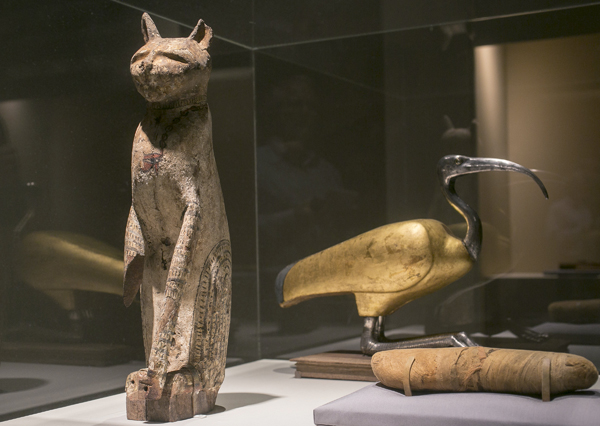Mummies of pharaoh’s best friend

A cat coffin with a mummy, left, and an ibis coffin are displayed at the Orange County’s Bowers Museum in Santa Ana, California.[AP/NEWSIS]
Others had their own special cemeteries, where they were buried in coffins as elaborately carved as those of royal family members.
Dozens of the best surviving specimens have taken up residence at Orange County’s Bowers Museum as the centerpiece of “Soulful Creatures: Animal Mummies in Ancient Egypt.”
There’s a dog so well detailed that its floppy ears are prominent. An ancient cat has been laid to rest with its little paws drawn across its body, creating an image eerily reminiscent of a human’s funeral pose.
“It just shows how Egyptians thought of animals on some basic level as being very similar to human beings,” said Edward Bleiberg, the exhibition’s curator. “The Egyptians believed animals had souls.”
But soulful or not, most people - other than a king or queen - couldn’t afford to keep a dog or cat around just for companionship in ancient times, Bleiberg said. Thus, the hunting dog waiting patiently under a chair in a dinner table scene etched onto an ancient tablet in the exhibition would likely have been shown the door if it hadn’t contributed to the meal.
Most animals had an even greater job. They were charged with the responsibility of using their souls in death to carry messages to the gods they had represented on Earth during their lives. The dog, for example, was the sacred votive or messenger of the god Anubis, depicted in Egyptian art as a man with the head of a dog.
The Ibis communicated directly with the god Thoth, who had the body of a man and head of a bird and who, it seems, was especially good at resolving human disagreements.
“There’s a letter included with one of the animal mummies that suggests there’s this man who is having a terrible problem at work,” said Bleiberg. “He has this rivalry with a co-worker, he’s certain that the co-worker is bad-mouthing him to the boss and making him look bad and he requests that Thoth make him stop.”
In all, the exhibition contains more than 100 items, including drawings and sculptures, as well as the mummified remains of dogs, cats, birds, snakes and crocodiles. Many are wrapped in intricately patterned linens, and some have been placed in sarcophaguses carved to resemble how the animal looked in life.
To give visitors a better look at what’s underneath the wrappings, the mummies have been CT scanned to create 3-D images.
Preparing animal mummies was detailed and expensive work. Bleiberg says an expert at the craft earned twice that of a farmer.
Animal mummifying was such big business that Ptolemaic III, who ruled Egypt more than 2,000 years ago, passed several decrees regulating the industry. One ordered that anyone who paid for an animal mummy really got one. How successful it was is open to debate: A CT scan of one exhibition mummy revealed nothing inside but rocks. Another showed feathers but no bird.
Like humans, the animals had to be cut open, salted and bathed in a substance like wine to be preserved. Archaeologists have found more than 30 Egyptian cemeteries created for animal mummies, some containing several million specimens.
Those in the exhibition come from the Brooklyn Museum in New York, of which Bleiberg is curator of Egyptian, Classical and Ancient Near Eastern Art.
AP










with the Korea JoongAng Daily
To write comments, please log in to one of the accounts.
Standards Board Policy (0/250자)